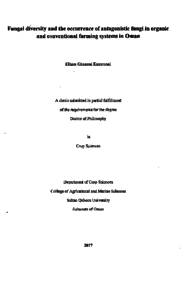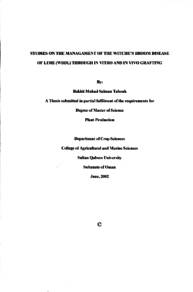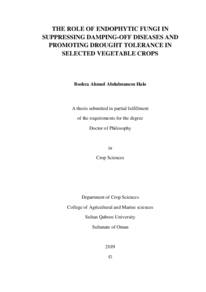Document
Fungal diversity and the occurrence of antagonistic fungi in organic and conventional farming systems in Oman
Publisher
Sultan Qaboos University
Gregorian
2017
Language
English
Subject
English abstract
In Oman, the farming system in the majority of farms follows a conventional system,
which is characterized by growing multiple crops mainly for home consumption, but
also for local market and sometimes for export. In addition, some farms have started
recently adopting organic farming. This study was conducted to assess fungal diversity
in the rhizosphere of crops under conventional and organic farming systems in Oman
and also to investigate for the potential presence of antagonistic fungal species that can
be used in future biocontrol programs.
The first part of the study dealt with evaluating the efficiency of direct plating in
comparison to pyrosequencing in estimating fungal diversity in soil, Analysis of 10
soil samples collected from two farms in Oman showed that pyrosequencing detected
More ara significantly more fungal phyla, classes and genera compared to direct plating. Pyrosequencing detected five unique fungal classes that were not recovered by direct plating. This could be related to the ability of pyrosequencing to detect uncultivable and slow growing fungal species.
The second part of the study analyzed fungal diversity in conventional and organic
farms growing cucumbers and tomatoes using pyrosequencing. Pyrosequencing results
revealed that fungal diversity varied between the different cultivation systems.
Richness estimates indicated that soils from the organic farms have higher fungal
diversity compared to soil from conventional farms. Ascomycota and Microsporidia
were the most dominant fungal phyla in most of the samples. Other dominant phyla
included Chytridiomycota and Basidiomycota, Microsporidetes, Dothideomycetes,
Eurotiomycetes and Leotiomycetes were the common classes in most soil samples.
Five and four unique classes were detected in the rhizospheres of cucumber and tomato
grown organically, respectively. The differential level of fungal diversity within and among farms could be related to the variation in the cultural practices employed. It also shows that organic farming favors higher levels of fungal diversity.
The last part of the study examined the biocontrol potential of 36 fungal isolates
obtained from the rhizospheres of tomato and cucumber in Oman against Pythium
aphanidermatum and Rhizoctonia solani, the causal agents of damping-off of cucumber. In vitro screening of the 36 fungal isolates against P. aphanidermatum and R. solani showed that isolates TO144 and TT266 were the most effective in inhibiting the mycelial growth of P. aphanidermatum and R. solani. Inoculation of cucumber seedlings with the antagonistic isolates TO144 and TT266 did not have any negative effects on the survival of cucumber seedlings. Isolate TT266 significantly improved
dry weight of cucumber seedlings compared to the control (P < 0.05). The two antagonistic fungal isolates significantly increased the survival of cucumber seedlings inoculated with P. aphanidermatum from 7% to 62% when T0144 was used and to 38% when TT266 was used. In addition, they also significantly increased the survival of cucumber seedlings inoculated with R. solani from 15% to 31% when T0144 was used and to 69% when TT266 was used. Identification of TO144 and TT266 to the
species level using sequences of the ITS region showed that they are Trichoderma asperellum and Talaromyces pinophilus, respectively. This is the first report of the potential of Talaromyces pinophilus as a biocontrol agent for Pythium and Rhizoctonia damping-off of cucumber. The study also shows that fungal isolates present in the rhizosphere of vegetable crops can be potential biocontrol agents for soil borne diseases.
Member of
Resource URL
Arabic abstract
يتبع النظام الزراعي في معظم المزارع في سلطنة عمان نظاما تقليديا يتميز بزراعة محاصيل متعددة تستخدم للاستهلاك المنزلي، وللأسوق المحلية واحيانا التصدير. وبالإضافة إلى ذلك، بدات بعض المزارع مؤخرا في تبني الزراعة العضوية، وقد أجريت هذه الدراسة لتقييم التنوع الفطري في المنطقة المحيطة بجذور المحاصيل في إطار نظم الزراعة التقليدية والعضوية في عمان، وكذلك التحقق من وجود انواع فطرية يمكن استخدامها في برامج المكافحة الحيوية تناول الجزء الأول من الدراسة تقيم كفاءة العزل المباشر بالمقارنة مع طريقة تفاعل سلسلة البايرو (pyrosequencing) في تقدير التنوع الفطري في التربة، حيث أظهر تحليل عشرة عينات من التربة تم جمعها من مزرعتين في عمان أن طريقة pyrosequencing أكثر كفائة بكثير في الكشف عن الفطريات مقارنة بالعزل المباشر. كشفت طريقة pyrosequencing خمسة طوائف فريدة من نوعها لم تكتشف بالعزل المباشر. ويمكن أن يكون هذا مرتبطا بقدرة pyrosequencing الكشف عن الأنواع الفطرية الغير القابلة للزراعة وكذلك الأنواع بطيئة النمو
أما الجزء الثاني من الدراسة فقد ركز على تحليل التنوع الفطري في المزارع التقليدية والعضوية التي تزرع الخيار والطماطم (البندورة) باستخدام تقنية pyrosequencing. كشفت النتائج أن التنوع القطري يختلف بين أنظمة الزراعة المختلفة. حيث وجد ان التربة من المزارع العضوية تمثلك تنوع فطري اعلى بالمقارنة مع التربة من المزارع التقليدية. كانت اسكوميكوتا و میکروسبوريديا (Ascomycota and Microsporidia ) اكثر شعب الفطريات السائدة في معظم العينات، كما وجدت كذلك شعب اخرى مثل تشيتريديوميكونا وباسيديوميكونا میکروسبوريديتس، دوئيدوميستس، وروتيوميستس و لیوتیومیست. (Chytridiomycota and and Eurotiomycetes Dothideomycetes, Microsporidetes, Basidiomycota. Leotiomycetes). تم الكشف عن ستة وأربع فئات فريدة من نوعها في المنطقة المحيطة بجذور الخيار والطماطم المزروع عضويا، على التوالي. ويمكن أن يرتبط المستوى التفاضلي للتنوع الفطري داخل المزارع وفيما بينها بالتفاوت في الممارسات الزراعية المستخدمة، كما تشير الدراسة إلى أن الزراعة العضوية تحتوي على مستويات أعلى من التنوع الفطري. أما الجزء الأخير من الدراسة فقد ركز على فعالية المكافحة الحيوية ل 36 عزلة فطرية تم الحصول عليها من المنطقة المحيطة بجذور الطماطم والخيار في عمان ضد فطري االبينوم أفانيدرماتوم وریزوكتونيا سولاني، واللذان يسببان موت بادرات الخيار. أظهر الفحص المختبري للعزلات الفطرية ال 36 ضد الجيثوم أفاقيدرماتوم والريزوكتونيا سولاني قدرة سلالتين (TO144 وTT266 ) على التأثير في نمو االبينوم أفانيدرماتوم والريزوكتونيا سولاني. لم لم تؤثر سلالات (TO144 و TT266 ) سلبا على شتلات الخيار، وفي المقابل حسنت VIT السلالة TT266 بشكل ملحوظ من الوزن الجاف لشتلات الخيار مقارنة مع الشاهد ( 0 . 05>P). عززت السلالات بشكل كبير من بقاء الخيار الملقح بالبينوم أفانيدرماتوم من 17 إلى 62. عندما تم استخدام T0144 وإلى 38% عندما تم استخدام TT266. وبالإضافة إلى ذلك، زادت بشكل ملحوظ من بقاء الخيار الملحق بالريزوكتونيا سولاني من 15% إلى 31% عندما تم استخدام TO144 وإلى 69% عندما تم استخدام TT266. اظهر التشخيص باستخلتم الحمض النووي انتماء السلالتين TO144 و TT266 الى تريكوديرما أسبریلوم و تالارومیسز بينوفيلوس، على التوالي. هذا هو التقرير الأول عن إمكانية استخدام تالارومیسز بينوفيلوس( Talaromyces pinophilus) كعامل مكافحة حيوية للبيثوم والريزوكتونيا المسببين لموت بادرات الخيار. وتبين الدراسة أيضا أن العزلات الفطرية الموجودة في منطقة الجذور في محاصيل الخضروات يمكن أن تكون عوامل مكافحة حيوية محتملة للأمراض التي تنتقل عن طريق التربة.
أما الجزء الثاني من الدراسة فقد ركز على تحليل التنوع الفطري في المزارع التقليدية والعضوية التي تزرع الخيار والطماطم (البندورة) باستخدام تقنية pyrosequencing. كشفت النتائج أن التنوع القطري يختلف بين أنظمة الزراعة المختلفة. حيث وجد ان التربة من المزارع العضوية تمثلك تنوع فطري اعلى بالمقارنة مع التربة من المزارع التقليدية. كانت اسكوميكوتا و میکروسبوريديا (Ascomycota and Microsporidia ) اكثر شعب الفطريات السائدة في معظم العينات، كما وجدت كذلك شعب اخرى مثل تشيتريديوميكونا وباسيديوميكونا میکروسبوريديتس، دوئيدوميستس، وروتيوميستس و لیوتیومیست. (Chytridiomycota and and Eurotiomycetes Dothideomycetes, Microsporidetes, Basidiomycota. Leotiomycetes). تم الكشف عن ستة وأربع فئات فريدة من نوعها في المنطقة المحيطة بجذور الخيار والطماطم المزروع عضويا، على التوالي. ويمكن أن يرتبط المستوى التفاضلي للتنوع الفطري داخل المزارع وفيما بينها بالتفاوت في الممارسات الزراعية المستخدمة، كما تشير الدراسة إلى أن الزراعة العضوية تحتوي على مستويات أعلى من التنوع الفطري. أما الجزء الأخير من الدراسة فقد ركز على فعالية المكافحة الحيوية ل 36 عزلة فطرية تم الحصول عليها من المنطقة المحيطة بجذور الطماطم والخيار في عمان ضد فطري االبينوم أفانيدرماتوم وریزوكتونيا سولاني، واللذان يسببان موت بادرات الخيار. أظهر الفحص المختبري للعزلات الفطرية ال 36 ضد الجيثوم أفاقيدرماتوم والريزوكتونيا سولاني قدرة سلالتين (TO144 وTT266 ) على التأثير في نمو االبينوم أفانيدرماتوم والريزوكتونيا سولاني. لم لم تؤثر سلالات (TO144 و TT266 ) سلبا على شتلات الخيار، وفي المقابل حسنت VIT السلالة TT266 بشكل ملحوظ من الوزن الجاف لشتلات الخيار مقارنة مع الشاهد ( 0 . 05>P). عززت السلالات بشكل كبير من بقاء الخيار الملقح بالبينوم أفانيدرماتوم من 17 إلى 62. عندما تم استخدام T0144 وإلى 38% عندما تم استخدام TT266. وبالإضافة إلى ذلك، زادت بشكل ملحوظ من بقاء الخيار الملحق بالريزوكتونيا سولاني من 15% إلى 31% عندما تم استخدام TO144 وإلى 69% عندما تم استخدام TT266. اظهر التشخيص باستخلتم الحمض النووي انتماء السلالتين TO144 و TT266 الى تريكوديرما أسبریلوم و تالارومیسز بينوفيلوس، على التوالي. هذا هو التقرير الأول عن إمكانية استخدام تالارومیسز بينوفيلوس( Talaromyces pinophilus) كعامل مكافحة حيوية للبيثوم والريزوكتونيا المسببين لموت بادرات الخيار. وتبين الدراسة أيضا أن العزلات الفطرية الموجودة في منطقة الجذور في محاصيل الخضروات يمكن أن تكون عوامل مكافحة حيوية محتملة للأمراض التي تنتقل عن طريق التربة.
Category
Theses and Dissertations



